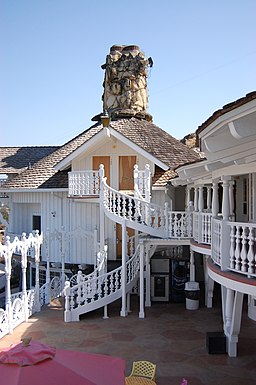Halfway between San Francisco and Los Angeles, a set of buildings celebrate over-the-top kitsch. Alex and Phyllis Madonna opened their eponymous hotel in 1958. The architecture avoids straight lines. Pepto Bismol pink bathes the common rooms; gilded, oversized cherubs perch over bannisters. The hotel’s signature pink cloud cocktail features strawberry-flavored vodka and mounds of whip cream.
The Madonnas chose to make every room different. The Austrian Suite (#160) has shiny damask wallpaper and round rococo tables. California Poppy (#172) has flowery walls with scalloped door frames painted bright orange. The floor, ceiling and walls of the Caveman Room (#137) are made of stone. Its rock shower offers a luxurious waterfall.
My husband and I spent the Fourth of July weekend there. Yes, it was silly, but the getaway left me awash in gratitude. I am grateful the life I am leading is not the life I was raised for.
While on a business trip earlier this year, I toured the Washington DC temple, which happened to be open to nonmembers temporarily after a renovation. Decades before, this was the first temple I entered as a faithful, active member. It was the summer after I’d turned twelve, old enough to perform baptisms for the dead. Under the diligent direction of adult leaders, my youth group washed cars and held bake sales to earn funds for the 11-hour road trip from my hometown in northern Alabama. I’d never even held hands with a boy, but I fretted over my interview with the bishop to confirm my worthiness.
It was strange to come to this temple again with no one’s direction or permission but my own. I must have been greeted every 200 hundred feet. At each turn in the path, someone stood positioned to smile and point directions.
I had forgotten that energetic Mormon cheer, the random dad jokes intended not to make you laugh but to show you’ve been noticed. The Mormon gaze can make you feel like you’re the most important person in the world. It also lets you know you’re a disappointment when you step off the path. When I reached the temple’s open oversized doors, a smiling young woman actually placed the disposable clean-shoe booties on my feet.
What I was most eager to see were the rooms I’d never been able to enter as a youth, the sealing rooms where marriages are performed. Tidy rows of upright upholstered chairs stood a few feet back from an altar, where the couple kneels. It looks a bit like a foreshortened coffin ringed by a plush skirt. It’s all off-whites and pastels, a picture of austere elegance.
The DC temple contains ten of these rooms. I asked the guide guarding the door how different the other rooms were and if couples visited ahead of time to pick their favorite. They’re all the same, he told me. You don’t get to choose. It was the answer I’d expected.
I learned as a Mormon that the purpose of our earthly existence is to gain a body and to show we’ve learned to make good choices. But those choices are pre-set and pre-defined: baptism, marriage, obedience to the Church. In so many ways, the ideal Mormon marriage is less about love than conformity.
Alex Madonna thought giving guests a choice would lift their spirits. The ‘celestial room’ of Just Heaven (#184) features a stairway to a private viewing tower. The ceiling of Gypsy Rock (#142) is bright yellow, pink, green and blue. The walls are granite boulders excavated nearby. They made the thick gray carpet feel softer. “I try to give people a decent place to stay where they receive more than they are entitled to,” Madonna told the New York Times in 1982. We arrived expecting the campy glitz, ready to play along in the game.
In the DC temple, I looked into that generic, interchangeable sealing room and felt I’d escaped a cage. The prophets say that any man and woman can make a marriage work, so long as both are sufficiently righteous, but even Mormons believe that a wedding is when you bind yourself to a special person, someone who fits you especially well. Only it’s most important to fit the Mormon mold. When I imagined the life where I would have knelt at that altar, I felt lonely. I think I was missing myself.
In that light, the gilded cherubs and stone sinks and stained glass of the Madonna Inn embody something much more profound than a profitable celebration of silliness. These rooms of exuberance and individuality make room for joy. To me, that says much more about the purpose of life than the Mormon temple’s elegant pastels.

Top Image: Omar Bárcena, CC BY 2.0, via Wikimedia Commons

Some years ago I walked through the Sacramento Temple before it opened. Our tour guide was a woman but we were flanked by a posse of 5 men–almost outnumbering the people in our group. We were told to “save our questions for the end” but when the end arrived, one of the men bore his testimony and then we were dismissed. 😉
The Mormon cheer and friendliness is a form of love-bombing, isn’t it?
(The Madonna Inn sounds wonderful!)
It’s kind of sad, actually, that the temple — which is supposed to be Mormonism’s little piece of heaven — is designed like a generic hotel lobby at best. (Then they tease people with the promise that you’re actually allowed to discuss and ask questions about the temple while you’re in it, but usher you out before you get the chance, as in Donna’s example.)
A place with a little originality like the Madonna Inn sounds so much more wonderful!
Funkiness, creativity, and variety are definitely preferable to (supposedly) elegant uniformity and sterility.